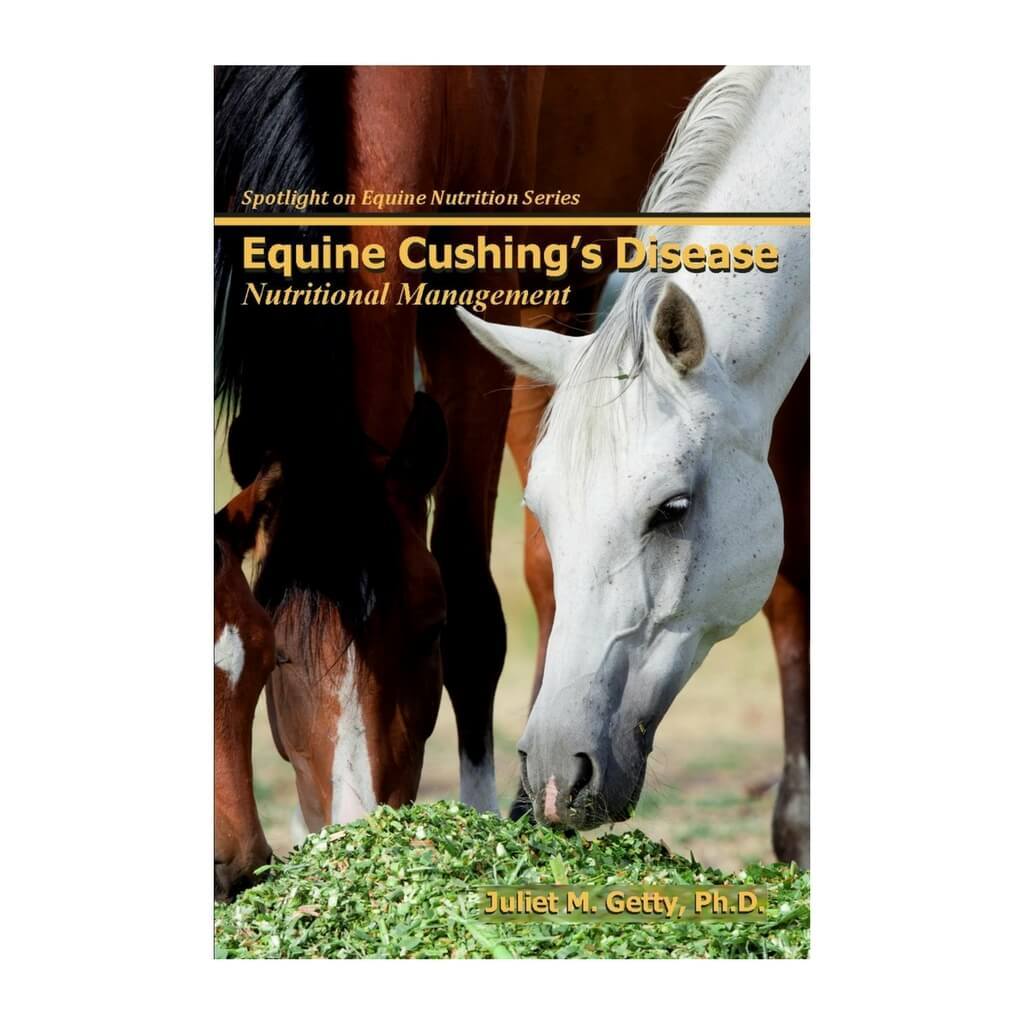-
Equine Cushing's disease is an incurable disorder common in older horses. The symptoms come on gradually, but can be devastating to a horse's quality of life. It is a progressive disorder that can lead to fatal infections, colic, muscle wasting, and laminitis. The good news, though, is that nutritional management can slow the disease progression and greatly improve the quality of life for the horse with Cushing's disease.
In this volume of her Spotlight on Equine Nutrition Series, Dr. Juliet M. Getty explains the science of the disease mechanism, discusses common veterinary options, and offers valuable advice on appropriate nutritional intervention, a key component in the treatment of equine Cushing's disease. Her answers to questions from owners of horses with Cushing's will be of help to many who struggle to better the lives of their suffering horses.
Highlights:
- How to successfully feed for weight loss
- Understanding hormonal cascade of normal and diseased states
- Appropriate supplements to lower circulating insulin levels
- How Pergolide and herbal choices work
- Explanation of oxidative stress and how to avoid it
About Dr. Juliet M. Getty
Juliet M. Getty, Ph.D. is an independent equine nutritionist with a wide U.S. and international following. Her research-based approach optimizes equine health by aligning physiology and instincts with correct feeding and nutrition practices. Dr. Getty’s goal is to empower the horseperson with the knowledge to provide the best nutrition for his or her horse’s needs.
Dr. Getty is the author of the comprehensive resource, Feed Your Horse Like a Horse, as well as seven topic-centered Spotlight on Equine Nutrition series of booklets:
- Whole Foods & Alternative Feeds
- Joint Health - A Nutritional Perspective
- Aging Horse - Help Your Horse Grow Old with Dignity and in Health
- Laminitis - A Scientific and Realistic Approach
- Easy Keeper - Making it Easy to Keep Him Healthy
- Equine Cushing's Disease - Nutritional Management
- Equine Digestion - It's Decidedly Different
Save on Book Packages!
- Save $2 when you buy any 2 Spotlight Titles (mix & match)
- Save $12 when you buy all 7 Spotlight Titles
- Save $28 when you buy all 7 Spotlight Titles + Feed Your Horse Like A Horse
She also offers an informative e-newsletter, Forage for Thought. Opt-In here. Her Resource Library offers a world of useful information for the horseperson, including a library of her past articles, tips and recordings. Her Free-Shipping Store helps horse owners choose the right supplement for their horse’s specific needs.
-
Excerpt from Equine Cushing's Disease - Nutritional Management
The All-important Pituitary Gland
Let’s look now at the pituitary gland and the damaging pathway of Cushing’s. The pituitary gland is suspended from the hypothalamus at the base of the brain. There are three significant hormone-releasing lobes of the pituitary gland. The first one is the pars distalis, which secretes prolactin, endorphins, growth hormones, follicle-stimulating hormone, luteinizing hormone, and thyroid-stimulating hormone. The second lobe is the pars nervosa, which controls water balance by secreting the antidiuretic hormone commonly known as vasopressin; it also secretes the hormone oxytocin. And finally, there’s the lobe involved with equine Cushing’s, and that is the pars intermedia. The pars intermedia produces peptide hormones known as proopiomelanocortin peptides (POMC, for short) which include things like alpha-MSH (melanocyte stimulating hormone, responsible for skin pigmentation) and beta-endorphins (which cause relaxation and improved pain tolerance); in horses this particular lobe produces ACTH, the regulation of which is at the heart of the Cushing’s problem itself.
Let’s look at a normal situation where the horse is experiencing some kind of stress—maybe he’s exercising intensely or has mental stress. He may be in pain, or suffering from an empty stomach (more on that later). It doesn’t matter what the cause of the stress is—whenever there’s some kind of stressor, the pituitary gland will release ACTH.
View Normal Hormonal Cascade (PDF).
The healthy body has a homeostatic mechanism to handle hormones: their levels can rise and fall and are maintained within a normal range. Stress stimulates the hypothalamus to release corticotropin releasing hormone (CRH). CRH signals the pituitary gland (pars intermedia) to release ACTH, which then stimulates the adrenal gland to secrete the stress-hormone known as cortisol. To bring cortisol levels back to normal, cortisol will stimulate certain neurons in the brain (hypothalamus) to produce the neurotransmitter, dopamine. Dopamine, in turn, tells the pituitary gland to stop secreting ACTH, which then causes cortisol production from the adrenal gland to subside.
However, with oxidative stress over a period of time, those dopamine-producing neurons that are activated by cortisol become fewer and fewer in number. The hypothalamus is no longer able to produce enough dopamine; without adequate dopamine to signal it to stop, the pituitary gland continues to pump out ACTH. An increase in ACTH then leads to an increase in cortisol levels, which in turn causes the pituitary gland to hypertrophy or enlarge. When that happens, the cells of the pars intermedia start to divide and enlarge; they can form tumors (benign adenomas), which can put pressure on the other areas of the pituitary gland as well as on the hypothalamus, leading to a whole variety of symptoms, the “dysfunction” part of the name, PPID. See chart on next page: Cortisol and Oxidative Stress.


